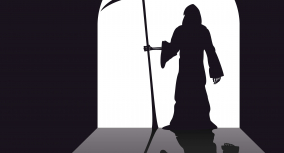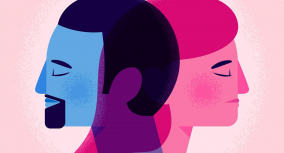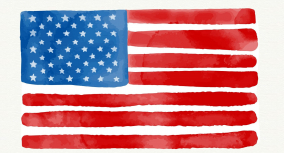Being no more than phenomena of light, colors take on many new meanings when used in literature. Color symbolism is studied by literary scholars, psychologists, and art historians. It has also been widely used in various works to help authors evoke emotions, deliver their messages, and create a specific atmosphere.
Many colors have universal meanings. For example, yellow can symbolize not only joy and optimism but also the darker sides of envy, sickness, or cowardice. Blue, in turn, often represents tranquility, while purple traditionally symbolizes nobility and wealth.
In this article by Custom-Writing.org, you will find:
- Explanations of colour symbolism and imagery
- Basic overview of color psychology
- Color meanings in literature: red, orange, yellow, green, blue, purple, white, and black
- A thorough analysis of color imagery used in various literary works
🎨 Color Symbolism in Literature: Definition
Color symbolism in literature refers to using colors in writing to represent something outside of their literal meaning. It influences readers’ understanding of a literary work and helps writers convey implicit messages without explaining things outright.
Psychology of Color in Art
Colors are something we see around us every day. There are two ways by which we assign meanings to them:
- Color-charged everyday experiences. For example, nature’s dominant shade is green. That’s why people often feel good when they see it.
- Cultural meanings and associations. These are not necessarily based on emotional connections. Think about the color red being a sign of danger or its use in traffic lights.
Naturally, what is typical for one culture, or even one person, might be entirely alien for another. There is no one way of explaining what a specific color stands for. It becomes especially evident in visual arts. Even the most abstract canvases can have a profound effect on the viewer purely through the choice of color.
Use of Colors in Literature
Now let’s get back to literature. In fiction and poetry, color symbolism has several functions:
Color Symbolism in the Bible
Biblical examples of color usage are among the most curious ones. Their spiritual meanings have affected the perception and the use of different pigments in religious art and liturgy.
For example, a rainbow, being a collection of many colors, has a huge significance. Sent after the Flood, the seven colors of the rainbow symbolize God’s promise to people to never try to destroy them again. Other examples include blue representing Heaven and red standing for humanity.
Color Symbolism in Greek Mythology
What is the ancient Greek term for blue? Well, no one really knows. The Greeks used colors in a slightly different way than we do. Homer, for example, used the word “kuaneos” to denote dark blue turning into black. Simple “blue” wasn’t an option.
According to Aeon.co, the value of color for ancient Greeks was based on its brightness, effect in differing light, and even the way it was obtained. For instance, purple and gold were highly valued since they were rare and costly to produce. Hence, they were associated with power, royalty, and beauty. Mythological gods and heroes would often be clothed in purple and gold – and not without reason. This is another example of how people may view color differently within their own cultures.
Color Symbolism in Poetry
Poets are no strangers to color symbolism. Remember the combination of purple and gold implying power and heroism? Poets of ancient times used it to express the same notions. Later on, Shakespeare also took up the habit of hinting at various emotional states through color (check out this article on the Elizabethan Era website to learn more about the use of colors in Shakespeare’s time.)
Color meanings change with time. For the authors of old, ancient meanings of colors implications were more or less the same. However, in modern poetry, the associations have become more subjective. Purple is not necessarily royal anymore, while blue doesn’t always have to mean sadness.
🌈 Color Meanings in Literature
Whether subjective or traditional, color symbolism can help you deepen your understanding of any literary work and its imagery. Colors don’t always have to mean something, but when they do, you want to be able to recognize that. Pay attention to a color if it’s repeated a few times throughout the story or if you feel it may be important for the plot.
Here are a few color symbolism examples:
What Does Red Symbolize in Literature?
Red is the color of roses, blood, and fire that combines positive and negative characteristics. On the one hand, it symbolizes love, passion, life, and protection. On the other hand, it represents evil, danger, violence, and destruction.
- As a fiery color, red implies warmth, as fire can maintain life.
- At the same time, fire can destroy. That’s one of the reasons why red is associated with danger. It can also be explained by the fact that red is stimulating on a physical level.
For example, red is frequently used in The Scarlet Letter. It comes into play as a symbol of sin and passion: the crime of adultery and its consequences.
Yellow in Literature: Symbolism
Yellow symbolizes happiness, optimism, and cheerfulness. At the same time, it is the color of sickness, madness, and cowardice. Yellow, just like any other color, is full of contradictions.
- A hot sunny day is full of yellow, which associates with positive emotions.
- At the same time, many poisonous animals and insects are colored in various hues of yellow. In this way, it becomes a danger signal.
- Meanwhile, the sickly yellowish tint of a patient’s skin brings to mind associations with disease.
In The Yellow Wallpaper, yellow has nothing to do with happiness. It represents mental instability and depression.
What Does Green Symbolize in Literature?
Green in literature usually means renewal and rebirth. We can describe the color as refreshing and calming. Its associations with nature are unequivocally positive. Still, the color green can hint at jealousy or disease in some contexts.
- The color of vegetation signifies spring, youth, and safety.
- Green is also the color of achievement and money.
- Shakespeare could be responsible for the connection between green and jealousy, calling it a “green-eyed monster.”
- Ancient Greeks connected green and illness. In this aspect, it is very similar to the color yellow because an ill person may have somewhat greenish skin.
In The Lord of the Flies, this color symbolizes the boys’ regression and return to the wilder state.
Blue Symbolism in Literature
Blue in literature represents calmness, serenity, and wisdom. The opposite end of the spectrum includes coldness, profound sorrow, and even depression.
- The association with the sky gives the color blue a sense of tranquility.
- The icy blue hue is representative of coldness and emotional distance.
- Blue is also associated with water: something alluring and a force to be reckoned with.
- In addition, culture has taught us that blue is the color of a grieving soul. Think, for example, of the blues as a musical genre.
Since the beginning of the 19th century, in German Romanticism, the Blue Flower (Blaue Blume) was a prominent symbol of desire and longing for something too far to reach.
The Color Purple Symbolism in Literature
The color purple combines the properties of red and blue: passion and serenity, respectively. The positive connotations of the color purple include mystery, creativity, and dignity. Among the negative ones are decay and arrogance.
- Due to the high price of obtaining the purple pigment, it became the color of royalty. Some people find this color garish or condescending because of this relation.
- Magic has also long been connected with purple thanks to its associations with the twilight and whimsy.
In The Color Purple, the titular shade stands for dignity regained by the main character. It also represents her developing creativity and self-identity in the search for love and purpose.
What Does White Symbolize in Literature?
White is the color of purity. In literature, it is a foolproof way to express the goodness, innocence, or morality of a character. Its negative meanings include lack of feelings and unhealthy perfectionism.
Here are some of its other meanings:
- As the color of untouched snow, white makes one think of coldness.
- White is sometimes considered to be colorless, and thus can symbolize absence.
- Finally, white is synonymous with pallor, hence its association with death.
In Moby-Dick, a lot of attention is paid to the color white. What begins as a reflection on this color as a symbol of beauty eventually becomes a depiction of terror.
Black Symbolism in Literature
In everyday life, black often symbolizes certainty, sophistication, and authority. It tends to be the color of evil, despair, death, and mourning in fiction. In that sense, black in literature is an unambiguous color.
- Black is known to absorb light. This property makes it mysterious and scary as a symbol of concealment.
- Black is the opposite of white, which makes it the opposite of everything good, pure, and innocent.
It is no surprise that Gothic literature exploited the symbolism of the color black to the fullest. In Poe’s The Raven, black is the ultimate symbol of death and grief, while the raven is a bird that symbolizes loss.
Gold Color Symbolism in Literature
Whenever gold is mentioned in a story, it’s the color of wealth, high status, and heroism. It is a bright color associated with success and generosity. However, it can also signify fakeness.
- Gold’s connection to wealth also allows it to represent arrogance and being a showoff.
- Gold has been used in religious buildings and attire since ancient times, connecting it with divinity.
In The Great Gatsby, gold is used to make an impression. The titular character is all about wealth and creating an image of high status.
📚 Color Symbolism in Literature: Examples
Now, let’s examine some of the most remarkable color usages in literature: The Great Gatsby, The Yellow Wallpaper, and Sir Gawain and the Green Knight.
The Great Gatsby Color Symbolism
There is a lot to say about color symbolism when it comes to The Great Gatsby. Color is abundant there: white, green, blue, and yellow are only a few examples.
- White has two strikingly different explanations in The Great Gatsby. It signifies Daisy’s perceived purity and the romantic hope that Jay Gatsby sees in her. But at the same time, since white represents absence, it also embodies her emptiness and blandness.
- Blue in The Great Gatsby symbolizes the sadness and longing that Gatsby feels at the thought of Daisy. It expresses his loneliness even though he’s surrounded by people.
- The color yellow in The Great Gatsby is synonymous with gold but only to an extent. Sometimes it replaces gold, showing its futility and superficiality.
The Great Gatsby Green Light Symbolism
Green is especially prominent in the book. Fitzgerald used it to express the following:
- Stability, serenity, and new hope. Perhaps the most iconic image from the novel is the green light at the end of Daisy’s dock. It can be considered the epitome of Gatsby’s hopes and dreams of the future.
- Envy. Green also embodies Gatsby’s desire for higher status and Daisy’s love.
- Money. The “greenbacks” are an unbeatable power in Gatsby’s world. They’re also the tool that he uses to attract Daisy’s attention.

If you want to learn more about the colors in the novel, check out our article on symbols in The Great Gatsby.
The Great Gatsby Quotes with Color Symbolism
Here are a few examples of color symbolism in the novel:
With an effort, Wilson left the shade and support of the doorway and, breathing hard, unscrewed the cap of the tank. In the sunlight his face was green.
The Great Gatsby, Nick Carraway, Chapter 7
They were both in white and their dresses were rippling and fluttering as if they had just been blown back in after a short flight around the house.
The Great Gatsby, Nick Carraway, Chapter 1
The lamp-light, bright on his boots and dull on the autumn-leaf yellow of her hair, glinted along the paper as she turned a page with a flutter of slender muscles in her arms.
The Great Gatsby, Nick Carraway, Chapter 1
Color Symbolism in The Yellow Wallpaper
In The Yellow Wallpaper, Charlotte Perkins Gilman outstandingly uses the color yellow. It is a multifaceted color, and the author presents it in various forms throughout the book.
It starts as a sickly unpleasant shade and gradually gets more and more sickening for the main character, who is suffering from a mental disorder. We can assume that staying in a nursery with a wallpaper of this color only worsens the narrator’s condition.
Here are the meanings that yellow has throughout the story:
- Staring at the bright wallpaper for a long time causes anger and aggression in the narrator.
- It also stands for cowardice, expressing the idea that the protagonist is afraid to stand up against her overbearing husband.
- Getting “yellowed,” like the wallpaper itself, can signify old age and decay that’s in store for the narrator.
- Finally, she breaks free and arrives at a better destination. We are presented with the positive symbolism of yellow—warmth and happiness.
Want to learn more? Feel free to read our article on literary devices in The Yellow Wallpaper!
The Yellow Wallpaper Symbolism Quotes
Let’s get a better look at how masterfully the color yellow is used to portray things we have mentioned above.
It is the strangest yellow, that wallpaper! It makes me think of all the yellow things I ever saw—not beautiful ones like buttercups, but old foul, bad yellow things.
The Yellow Wallpaper, Narrator
The color is repellent, almost revolting; a smouldering unclean yellow, strangely faded by the slow-turning sunlight. It is a dull yet lurid orange in some places, a sickly sulphur tint in others. No wonder the children hated it! I should hate it myself if I had to live in this room long.
The Yellow Wallpaper, Narrator
I don’t want to go outside. I won’t, even if Jennie asks me to. For outside you have to creep on the ground, and everything is green instead of yellow.
The Yellow Wallpaper, Narrator
Color Symbolism in Sir Gawain and the Green Knight
This famous Middle-English Arthurian legend of unknown origin has one color as its centerpiece. Several fundamental elements of the poem are green. Let’s go over them.
- First, we have the Green Knight himself upon his green horse. He is dressed in green and bears a holly branch in one hand and an axe in the other. It’s impossible to forget that the color green’s strongest association is with nature and everything in it. Indeed, the Green Knight proves to be incredibly, even inhumanly strong. But these very qualities that he possesses also remind us of other interpretations of the color: magic and the supernatural.
- Then, there is the Green Chapel. It is where the second meeting of Gawain and the Green Knight is supposed to happen. Some interpretations suggest that green is no longer the color of nature here. It transforms into the shade of evil, making the Green Chapel a dark, ill omen.
Green is not the only prominent color in the poem. Another example of a symbol that deserves attention is gold. It could be a testament to Gawain’s wealth, though not in the literal sense, but rather in terms of morality and purity.
You can learn more on this subject from our article on symbols in Sir Gawain and the Green Knight.
Sir Gawain and the Green Knight Quotes with Color Symbolism
Here are a few examples of color symbolism in Sir Gawain and the Green Knight:
The horse that he rides [is] entirely of that colour,
Sir Gawain, Narrator, Part I, Lines 173-178
in truth.
A green horse huge and strong,
A proud steed to restrain,
Spirited under bridle,
But obedient to the man.
But then the weather on earth battles with winter,
Sir Gawain, Narrator, Part II, Lines 504-511
The cold shrinks downwards, clouds rise higher,
And shed sparkling rain in warming showers,
Falling on smiling plains where flowers unfold.
Both open fields and woodlands put on green dress;
Birds hasten to build, and rapturously sing
For joy of gentle summer that follows next
on the slopes.
For long there was only staring at the man,
Sir Gawain, Narrator, Part I, Lines 232-236
For everyone marvelled what it could mean
That a knight and a horse might take such a colour
And become green as grass, and greener it seemed
Than green enamel shining on gold.
We have provided you with some examples of color symbolism in the most color-loaded literary works. We hope you have learned something new! What are your favorite color interpretations in literature? Tell us in the comments!
🔍 References
- The Science of Color Explained by Art: Invaluable.com
- Is There Any Significance to Colors in the Bible?: Christianity.com
- Meaning of Red: Color Psychology and Symbolism: Sensational Color
- The Color Psychology of Green: Verywell Mind
- The Curious Symbolism of the Color White in Literature and Myth: Interesting Literature
- Examples of the Symbolism of Colors in The Great Gatsby: Seattle Pi
- Feminist Gothic in The Yellow Wallpaper: Lone Star College
- The Green Knight: A Symbol of Life, Death and Rebirth?: Hanover College











